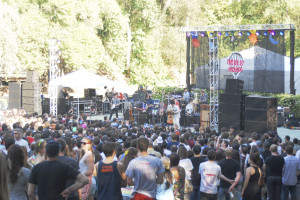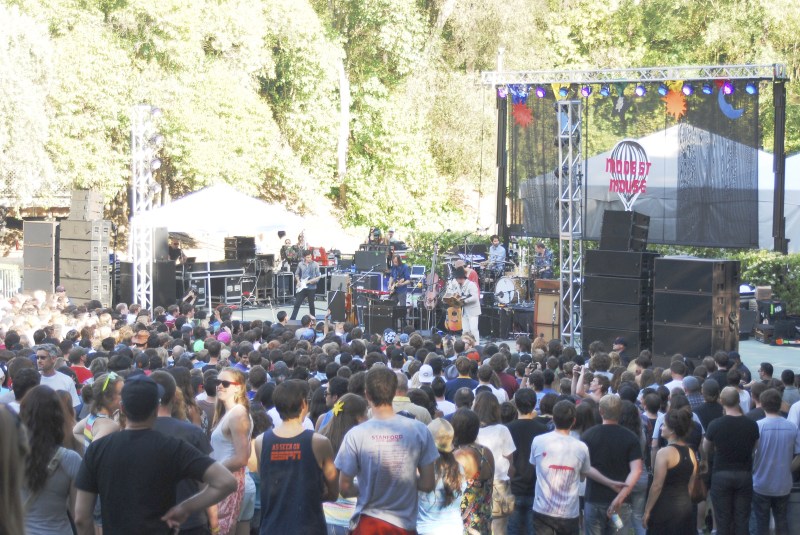The Frost Music and Arts Festival — featuring psychedelic rock band MGMT and opening acts Delorean and Kuroma — returns tomorrow for its second year, with this year’s iteration marked by greater student involvement in event coordination and efforts to promote future financial and attendance growth.

All 5,000 festival tickets had sold out by Thursday. SCN allotted 2,000 tickets for undergraduate students, 1,500 tickets for the general public and about 650 to 700 tickets for graduate students based on last year’s attendance, according to Frances Ball ’15, financial director for the Stanford Concert Network (SCN).
Haley Sayres ’14, director of SCN, noted that last year’s success prompted organization for this year’s event to occur more efficiently.
“There’s a lot more organization, since last year was kind of a trial run,” Sayres said. “Now, we know where to look for food vendors and how to set up security.”
This year’s festival also promises to feature more student art.
“We have increased the arts budget substantially, and that itself became its own class offered in the [Mechanical Engineering] Department,” Sayres said, referencing ME 191: Engineering Problems and Experimental Investigation.
SCN received a $20,000 donation from the Stanford Arts Institute to fund the student art projects and pay for more opening acts.
Matthew Tiews M.A. ’99 Ph.D. ’04, executive director of arts programs, said that one of the primary goals of the Institute is to support student art-making and creative expression.
“I certainly hope we will be able to do even more to foster a vibrant concert culture at Stanford going forward,” Tiews said.
Financial Stability
According to Ball, Frost’s budget is in much better shape compared to last year’s. The event’s headliners totaled about $90,000 and preparation costs amounted to about $100,000.
“A lot of expenses were last minute, things we didn’t foresee,” Ball said. “Now, we have a pretty good idea of what we need and started planning as early as October.”
She noted, however, that the event received more donations last year.
“A lot of departments gave us around $10,000 to $20,000 because it was the first time that Frost was being done after so many years,” she said.
This year, most of the funding came from special fees, the Office of Alcohol Policy and Education (OAPE) and the Graduate
Student Council (GSC). SCN received $163,450 in total through this year’s special fees process, while OAPE and the GSC donated $7,500 and $5,000 respectively to the event.
“The contribution from the GSC was intended for marketing purposes,” Ball said. “They wanted us to encourage graduate students to go, so that covered various expenses, such as posters.”
Revenue from last year’s ticket sales also supported an increase in this year’s budget. Almost 5,000 attendees filled Frost Amphitheater for last year’s concert, the first of its size in the venue since the 1980s.
“We made about $60,000 from ticket sales last year, and this year we’ve already surpassed that,” Ball said.
SCN received a number of complaints from students, however, because tickets at the discounted price sold out quickly.
“There is definitely a much higher demand this year, especially for group ticket sales, which went over than what we expected,” Ball said. “But we’re also more than breaking even, which is good.”
A growing culture
Snehal Naik, associate director of Student Activities and Leadership and direct advisor to SCN, expressed confidence that given the success of last year’s festival, Frost will be here to stay as long as it continues to draw sizeable crowds.
“Frost used to be this huge venue where all kinds of artists played,” Naik said. “I would love for it to become another Greek Theatre that competes with other venues in the Bay Area.”
Sayres maintained that although Frost is on course to become a self-sustaining financial model, it would never recreate its heyday.
“We can strive to have that same vibe and feel, but it will never be as laid-back because there are lot more considerations now than in the ’70s and ’80s,” Sayres said.
She expressed hope, however, that Frost would become a Stanford tradition while enjoying further increases in student interest.
“[The concert culture] is developing on its own,” Sayres said. “We see it with the trend in music festivals, such as the number of people going to Coachella, which has increased exponentially.
“Frost could potentially turn into an all-day event, and we would have more money to pay for bigger openers,” she added.
Naik framed hosting a diverse range of performers as another avenue for exploration.
“Music is tough in that you can’t please everybody,” Naik said. “I think as long as we offer diverse types of music, it will strengthen the culture on campus. There are endless possibilities.”
